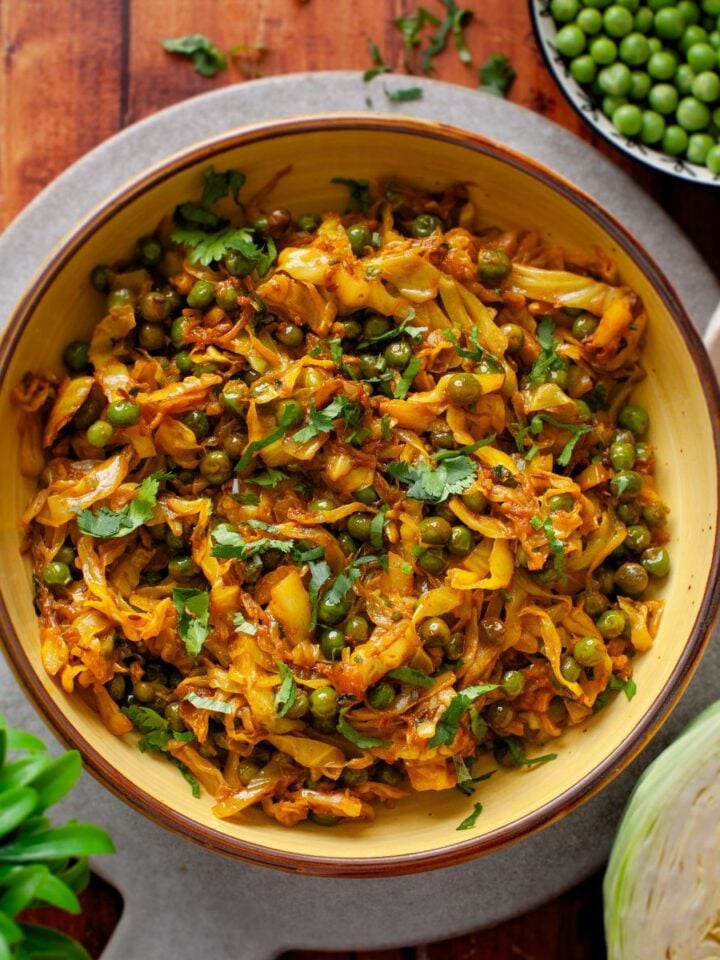Arbi ki sabji is a simple indian vegan dry curry made with taro root, green chillies and few spices. This no onion no garlic sabji is also called as arbi ki bhujia, this sabji is easy to make and gets ready in 20-25 minutes. It is a so flavorful & hearty and pairs well with indian flatbreads.

I could go on and on about my love for vegetarian dry curries and this arbi sabji is my summer favorite with rotis or as a side to lentils (dal - chawal. Mom used to make arbi and arbi patta(leaf) many ways and this delicious arbi bhujia used to be on the menu at least once every week. It is hard to believe how such simple indian dishes can elevate meals.
Since its made without onion or garlic, this arbi sabzi is perfect on days when you are fasting(vrat), just make sure to skip or substitute spices accordingly. Due to how delicious arbi in itself is, this sabji needs minimal spices and the texture is wonderful. I sometimes pair arbi together with potatoes while making it - pure comfort food.
What is Arbi?
Arbi or Arvi or Ghuyia(in Hindi) is called taro root in English. It is a starchy vegetable found extensively in indian subcontinent, south east asia and is also quite popular in caribbean & west african cooking.
It is an underground stem of Colocasia plant and resembles bulbs. Both the root and leaves of colocasia plant are edible and there are ton of recipes in indian cuisine using both. Arbi is similar to potatoes in the sense that its a root vegetable, but its sticky and slimy and the taste and texture sets it apart. It's skin is hairy and brown however the inside is fleshy, sweet and may be white, pink or purple colored.
Taro comes in all shapes and sizes- from size of a finger to large tubers. For making sabji, I usually purchase it from Indian stores or asian grocers. I have also seen it at American stores like Sprouts. Asian grocers stock many varieties of taro but pick these small ones as you see in the pictures.

Few Things to Keep in Mind When Cooking Arbi
- Because of certain chemicals in its skin, raw arbi will make your hands itch when you prep and peel it. You can wear gloves while peeling. Other option is to generously rub oil on your hands (I do this) because I find it difficult to cut it while wearing gloves due to its sliminess.
- Always add ajwain when cooking arbi dishes. The reason begin that arbi is a dense vegetable which can be difficult to digest for some people. Ajwain or carraway seeds add a unique flavor to arbi dishes.
- Always add an acidic element when you cook arbi. Traditionally in north india- amchoor is used. Amchoor is dried mango powder and is used to add tang to many dishes. Use lemon juice if you dont have amchoor.
Ingredients

- Arbi (Taro) - Use firm, fresh and small size arbi. It is easily available in indian & asian stores. You can add a potato as well if you wish, I do it many times. Cut potatoes and arbi in a similar lengthwise fashion.
- Oil - I use mustard oil for the authentic taste, however you can use any cooking oil.
- Spices - Ajwain, Hing & Carrom Seeds.
- Tangy Spices - Amchoor & Chaat Masala
- Other Ingredients - Salt, Cilantro, Red Chilli Powder
How To Make Arbi ki Sabji (Step By Step Pictures)




- Rub oil on your palms. Using a peeler, peel the arbi skins. Also peel potatoes if using.
- Cut the arbi lengthwise in half.
- If they are too thick, half each half lengthwise. Using a sharp knife, slice lengthwise in thick sticks similar to how we cut hand cut fries.
- In a wok, heat up the oil.
- Temper oil with cumin, ajwain and hing. Let crackle.
- Add the green chillies and red chilli powder. Stir for 20 seconds or so to makes sure that the oil is nicely flavored.
- Add the arbi and potatoes (if using) to the oil. Sprinkle salt.
- Stir around for a couple minutes to coat the vegetables in spices and oil.
- Cover, set stove to low medium and let cook until arbi is fork tender. Takes about 6-8 minutes. Both arbi and potatoes cook in almost same time so they both will cook.
- Using a fork make sure that the vegetables are soft. Tip : - Dont let them get mushy.
- Sprinkle chaat masala and amchoor. Stir fry on high heat for 2-3 minutes. Finish with cilantro. We love it with rotis, paratha or poori. It packs well in tiffins and can be also served with dal chawal.


Cooking sabji in iron kadai
I love to cook most indian sabji in iron kadai (non enameled). Unless there is a lot of tomatoes going in, iron kadai is one of the best utensils out there. Once you have cooked the sabji and finished it with lemon, amchoor, tamarind, kokum or chaat masala, do make sure to immediately plate the sabji out in a non reactive container like glass or steel after you have finished cooking. Dont let the cooked sabji sit in iron kadai once you have added the sour ingredient.
Recipe Tips
- After peeling arbi, make sure to wash them. After washing, dry them completely before cutting. Wet arbi = slimy sabzi.
- Dont skimp on oil. Arbi is one of those vegetables that need a little extra oil.
- Dont skip ajwain and hing. You can find both these spices in indian stores.
- Dont over cook the arbi, it will become sticky and slimy and won't taste good.
- Adjust cooking time a little depending on the size and quality of arbi. As a thumb rule, cover and cook arbi till fork tender but not falling apart. Then stir fry on high heat.


Arbi Ki Sabji
Ingredients
- 1 lb (450g) arbi taro/colocasia
- 1 small potato optional
- 4 tablespoon oil I use mustard oil
- ½ teaspoon ajwain seeds caraway seeds
- 1.5 teaspoon cumin seeds
- ¼ teaspoon hing
- 3 green chillies slit, hot variety, adjust to taste
- ¾ teaspoon red chilli powder I used extra hot red chilli powder, adjust to taste
- 1 teaspoon salt
- ¾ teaspoon chaat masala
- ¼ teaspoon amchoor adjust to how tangy you like
- 2 tablespoon cilantro chopped
Instructions
- Wear gloves or generously rub oil on your hands before starting to prep arbi.
- Using a peeler, peel off the skins of the arbi and potatoes (if using). Wash under running water. Completely dry with a kitchen towel.
- Using a sharp knife, slice both the vegetables length wise into half. Cut batons from each half.Note:- Make sure to cut both arbi and potato in similar fashion and same sizes.
- Heat up the oil in a kadai or pan on medium. If you are using mustard oil, let it get a little smoky to do away the raw smell.
- Temper the oil with ajwain, cumin,green chillies and hing powder. Stir for 10-12 seconds and add the red chilli powder. Stir for 5 seconds.
- Add the arbi and potatoes. Add the salt and stir around for 1 minute or so to coat in spices and oil.
- Reduce heat to low medium, cover and let cook for 6-8 minutes or till arbi is fork tender but not mushy.
- Uncover and add the amchoor and chaat masala. On high heat, stir for 1-2 seconds while moving around gently. Some of the arbi will get browned and that's what we want.
- Sprinkle with cilantro. Serve.
Notes
- After peeling arbi, make sure to wash them. After washing, dry them completely before cutting. Wet arbi = slimy sabzi.
- Dont skimp on oil. Arbi is one of those vegetables that need a little extra oil.
- Dont skip ajwain and hing. You can find both these spices in indian stores.
- Dont over cook the arbi, it will become sticky and slimy and won't taste good.
- Adjust cooking time a little depending on the size and quality of arbi. As a thumb rule, cover and cook arbi till fork tender but not falling apart. Then stir fry on high heat.






I'd Love to Hear from You!